Church of Saint-Sulpice, Jumet
| Saint-Sulpice church in Jumet | |
|---|---|
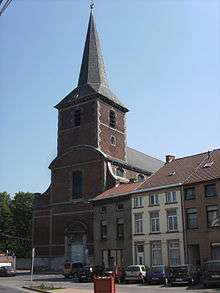 | |
| Basic information | |
| Location | Charleroi, Hainaut, Belgium |
| Geographic coordinates | 50°27′03″N 4°25′33″E / 50.450875°N 4.425897°ECoordinates: 50°27′03″N 4°25′33″E / 50.450875°N 4.425897°E |
| Affiliation | Roman Catholic |
| Municipality |
|
| District | Diocese of Tournai |
| Province |
|
| Region |
|
| Ecclesiastical or organizational status | Church |
| Status | Active |
| Heritage designation | 1949 |
| Groundbreaking | 1750 |
| Completed | 1753 |
Saint-Sulpice (French pronunciation: [sɛ̃sylpis]) is a Roman Catholic church in Jumet, a section of the Belgian town of Charleroi within the Walloon region in the Province of Hainaut.[1] It is dedicated to Sulpitius the Pious.
The oldest material traces of a religious building on the site date back from the 10th century. Three churches preceding the current construction were identified during an excavation that took place in 1967. Of a classical style, the current building was built between 1750 and 1753 by an anonymous architect.[2] The brick and limestone church is quite homogeneous. It is listed since 1949 by the cultural heritage.
Historical context
The church, as well as Jumet, are mentioned in 868 in the Lobbes Abbey polyptych.[3][4] So it is quite ancient but rarely mentioned in the texts. The destruction of State Archives of Mons and of the Tournai diocese at the beginning of the Second World War probably destroyed most of the documents relating to it.[5]
During the Ancien Régime, Jumet belonged to the Prince-Bishopric of Liège, the abbot of Lobbes was sovereign lord by appointment of the Prince-bishop.[6] This sovereignship of Liège is nonetheless contested by its Hainaut and Brabant neighbours. During the era, Brabant imposes itself more and more and therefore answering the local population's wish.[7] In the 1730s, Brabant acts as if Jumet was its full possession. During the 1740s, the duchess Maria Theresa of Austria and the Sovereign Council of Brabant grant, on demand of the mayor and the aldermans, administration laws. Finally, on the 28 june 1780, the Prince-bishop yields the lordship of Jumet which becomes officially brabantine.[8]
During the French era, Jumet will belong to the département of Jemappes that becomes part of the province of Hainaut after the fall of Napoleon.
The different churches that precede the current construction (the patron saint is unknown), were those of a parish of the old deanery of Fleurus belonging to the diocese of Liège. In 1559, during the erection of the new dioceses of Low Countries, this parish is attached to the newly created diocese of Namur,[9] then finally to the diocese of Tournai during the Concordat of 1801.
The digs of 1967
In 1967, the church underwent an important restoration led by Simon Brigode, architect and professor of the University of Leuven. During this restoration, digs were conducted from 16 to 22 August 1967 directed by Luc-Francis Genicot, then a associate professor at the University of Leuven.
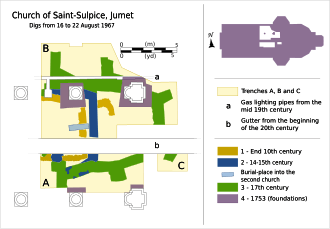
These digs were in a small but significant area,[10] while the restoration works had already destroyed some of the ancient foundations.[11]
Construction of the current church had already profoundly modified the site. The paving of the 18th century is lower than the earlier ones. The old foundations are only kept at their lowest levels, near the ground. During the digs no foundation projection, no under pavement, beginning of intonaco, nor altar base were excavated.[11] The burial-place lay only 19 centimetres (7.5 in) under the current pavement level.[12]
The work done in the 19th and 20th centuries removed ancient traces. A thin brick gutter, destined for the gas lighting pipes was installed during the second half of the 19th century, cross the B trench.[13] A gutter of the beginning of the 20th century, built roughly along the lengthwise axis of the current church, has cut through the old foundations.[14]
The probing surveys have allowed to correctly locate the successive stages of the church's growth.[12]
The successive churches
Three religious buildings that preceded the current church were uncovered during the excavation digs.
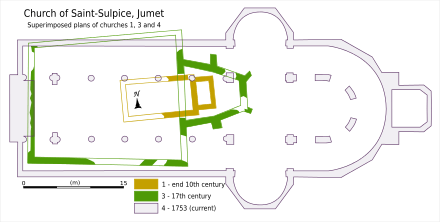
First church
Pre-Romanesque, the first building was formed of a rectangular chamber composed of a plain nave of a 4.7 metres (5.1 yd) width and a length that the digs have not managed to specify. It is possible, as in other small Early Middle Ages churches, that the length was the double of the width. It may be the edifice consecrated between 959 and 971 by Eraclus, abbot of Lobbes and bishop of Liège mentioned in the Eraclus charter.[15]
Second church
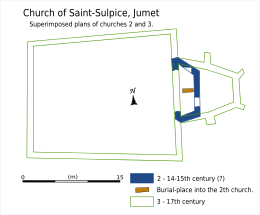
During the digs, the only part of the second church found was the foundation of an irregular three-sided apse. It is impossible to precisely define how the building developed towards the narthex. We do know that that side ended with a tower because Jehan Camal, the local priest, in a will dated from 1517, bequeathed 50 pounds towards the tower's repairs and the installation of a bell.[16] The tower is probably the same that is mentioned in the 17th century and that will be demolished for the construction of the 18th century church.[17] The size of the choir leaves us to suppose a three apsed construction, maybe similar to the one of the third church,[18] especially that an Pouillé (ecclesiastical register) of 1445 mentions an altar devoted to saint Nicholas and an other one in 1518 mentioning an altar devoted to the Virgin Mary,[19] as well as the main altar.
Noting the similarities with the Saint-Martin's church of Marcinelle choir rebuilt at the end of the 15th century, Luc-Francis Genicot submits the hypothesis that the latter took inspiration from Jumet's earlier adopted formula, maybe during the 14th century.[20]
In the choir, lies a burial place containing a squeleton in a nailed oak coffin. The presence of embroidered cloth and the location leave us to suppose that it is the tomb of a priest, likely the local parson.[21]
Third church
The choir of the third edifice dates back probably to the middle of the 17th century.[22] This church is eight times bigger than the first. The choir is of a Pentagon design 8.25 metres (9.02 yd) deep. It is consolidated by four buttresses, which allows us to suppose that it was once covered by a solid vault, probably of gothic design. the nave,22 metres (24 yd) long and of an estimated width of 20 metres (22 yd), is slightly trapezium shaped[23] and also with two aisles. The scale of the aisles let's us imagine a building of the hall church type, as many existed in Hainault since the 15th and 16th century.
Against the church frontage stands the before mentioned tower. It underwent an important restoration in 1670 and a clock is installed in 1681. This bell-tower is probably of a square design of roughly 6.4 metres (7.0 yd) a side. It is topped by an octagonal pointed spire, topped by a big finial cross and a weathercock peaking at 38 metres (42 yd) high.[2]
In 1710, the state of the church requests again serious repairs and Jumet's bailiff, Jean de Vigneron, asks the abbot of Lobbes, big tithe collector, the construction of a new church. The abbey can't meet the expenses.[24] Finally, after the trial, an understanding is concluded for the repairs of the church including the choir, the tower and the roof of the nave.[25]
Present church

The present church was built between 1750 and 1753 by an anonymous architect. The original plans consist of five coloured sheets.[26] They are numbered from A to E without any logical order, probably after the completion of the construction. The C sheet did not belong to the first file, but the five drawings are from the same person. The E sheet has notes on the back with twice the name of D. De Lados, which could be the name of the architect.[27]
Before 1750, the old church was demolished and the ground levelled[11] to welcome the intended sized building. this levelling is probably why the present church isn't correctly oriented, unlike the primitive church who's choir was perfectly facing the east.[28]
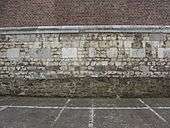
The design was ambitious and excessive for the locality of the time. Struggles happen between the architect and the sponsors including the abbot of Lobbes, Théodulphe Barnabé (abbot from 1728 to 1752).[25] The construction lags and, eventhough the old materials are re-used in the base and the pavings,[22] The cost is multiplied by five the original expectations :
| “ | We have been greatly wronged for the erection of this church [...] because the church building, instead of costing us twenty thousand florins, it's now costing us at least a hundred thousand [...] The architect has deceived us by increasing the length of the so-mentioned church by twenty nine feet, and many other things | ” | |
| — Complaint quoted by L-F. Genicot, [25] | |||
The initial plan intended to re-integrate the old tower. An amendment definitely scraped all the past.[22] The project of a new tower probably belonged to that part of the many other things that were mentioned in the complaint.
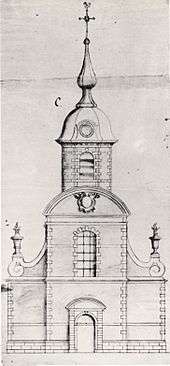
This conflict ends by a trial in front of the Sovereign council of Brabant. The architect must reduces his pretentions. To notice you just have to examine the successive frontage projects[28] and to compare the size of the achieved high parts and the planned size on the original elevation drawing. The building continues but, mind you with some delay. The church is finished in 1753.[22]
The steeple is developed to receive three bells. Two bells attested, there is no formal proof as to the existence of the third.[29]
On the east side, a bell of 1590 is adorned with the image of the virgin and has the inscription: Micael Willelmus coadiutor Lobiensis me fecit[30] – 1590 – Maître Jean Grongnart, founder[29][31]
On the west side, the second bell was probably in bad shape because it was remelted in 1772, as the inscription attests : + In the year 1772 I was remelted at the expense of the community of Jumet by the Simon Chevresson and Deforest.[29]
It's probable that the French revolution induced structural damage because a budget was allocated by the local administration for the repair of the panes and the roof in 1797.[32] In 1808, three new altars are built.[33]
In 1835, the church underwent an important restoration. Part of the pavement was replaced, a new set of furniture was put in, the altars transformed[32] and the master altar newly devoted.[33]
In the brickwork of the master altar, taken away during the 1968 restorations, was found a wooden casket reliquary closed by a glass lid. It contains two bones held together by copper thread. Between them, is a paper document in a very bad shape, nearly unreadable. It is dated 1835 : It is possible that the reliquary is older and that it was put there while the new devotion of the new altar.[34][35]
In 1840, a pipe organ was installed, the work of organ builder Hypolite Loret of Brussels. The instrument was upgraded in 1873.[32]
In 1943, the German occupation authorities commandeered the bells. The 1590 bell was grounded and sent to Germany.[36] After the war, It was found again and re-instated in the steeple.[28][37]
Architecture and furniture
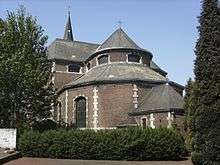
Of classic conception, the brick and limestone church is very homogeneous. It's composed of a six bayed nave flanked by aisles, of a three sided transept and of a choir with a polygonal ambulatory with a sacristy in its axis. The chamfered base is in dimension stone for the frontage, in rubble stones and sandstone for the rest. All the angles of the building are toothed and one in every stone is bossed.[1]
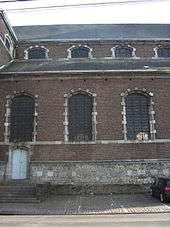
The windows, except the ones of the tower, all have a gouged limestone frame cut with protuding tooths (?), with a curved arch and window aprons joined together by a limestone band going around the whole building. Similar conceived half-windows are found on the second level in the background, under the cornice.[1]
The frontage has two levels with above them a curved pediment. On the first level, two belts proceed further than the central part to the side frontages under the voluted ailerons placed on both sides of the second level. Above the pediment, a square tower is made up of two stories separated by a belt. The tower has a polygonal steeple on a pyramidal base. The limestone portal is preceded by several steps. It's flanked by pilasters with crosswalls that hold an entablature and a curved pediment. There is an arched door.[1]
A secondary door, preceded by ten steps, is pierced by the first north aisle bay.
The interior is quite bright, painted in white and grey. It is covered by barrel vaults. The columns of the nave are of tuscan style. The piers of the choir and of the transept are crowned with a voluted capitals.[1]
The church contains noted panelling and furniture.[38]
In the church is a baptismal font from the 11th or 12th century. They consist of a stone bowl slightly flared circular flanked by four engaged columns that rely on a base. The columns end with a roughly cut human head. Two heads of four remain. These archaic way treated heads reminds most romanesque fonts in the country: straight nose and barely cleared, skin-deep eyes, mouth expressionless. These details are characteristic of romanesque workshops from the 11th and 12th centuries. However, the disposal of Jumet differs from other fonts known by the feature that the heads are borne directly by columns. Usually, the head is supported in cantilever by a kind of console, as is the case, for example, in Gerpinnes.[39]
The furniture also contains an altar devoted to Our-Lady of Tongre and a communion bench dating both from the 17th century.[38]
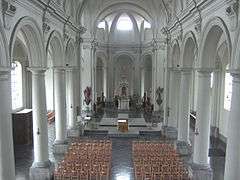 General view of the nave from the choir loft.
General view of the nave from the choir loft.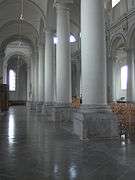 The north aisle and tuscan columns, towards the choir.
The north aisle and tuscan columns, towards the choir.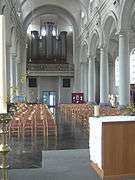 The nave and organs as seen from the choir.
The nave and organs as seen from the choir.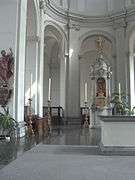 The choir with ambulatory, the tabernacle and the altar.
The choir with ambulatory, the tabernacle and the altar.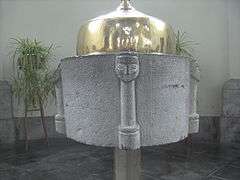 The baptismal font[32]
The baptismal font[32]
See also
| Wikimedia Commons has media related to Church of Saint-Sulpice, Jumet. |
References
- 1 2 3 4 5 PMDB 1994, p. 126.
- 1 2 Genicot 1969, p. 33
- ↑ Genicot 1969, p. 10
- ↑ Arcq 1973, p. 100
- ↑ Genicot 1969, p. 12
- ↑ Arcq 1973, p. 52
- ↑ Arcq 1973, p. 53
- ↑ Arcq 1973, p. 61
- ↑ Genicot 1969, pp. 11–12
- ↑ Genicot 1969, p. 9
- 1 2 3 Genicot 1969, p. 18
- 1 2 Genicot 1969, p. 19
- ↑ Genicot 1969, p. 22
- ↑ Genicot 1969, p. 20
- ↑ Genicot 1969, p. 25
- ↑ Arcq 1973, p. 102
- ↑ Genicot 1969, p. 30
- ↑ Genicot 1969, p. 27
- ↑ Arcq 1973, p. 101
- ↑ Genicot 1969, p. 28
- ↑ Genicot 1969, pp. 38–39
- 1 2 3 4 Genicot 1969, p. 36
- ↑ Considering that the restitution is correct, because the south-west angle hasn't been maintained (Genicot 1969, p. 30).
- ↑ Arcq 1973, p. 103
- 1 2 3 Genicot 1969, p. 15
- ↑ Kept at State Archives in Belgium (Genicot 1969, p. 16)
- ↑ Genicot 1969, p. 16 ; 17
- 1 2 3 Arcq 1973, p. 104
- 1 2 3 Arcq 1973, p. 104 ; 106
- ↑ Michel Willame was co-helper from 1580 to 1598 of the abbey of Lobbes, Ermin François, he was elected himself in 1598 and died in 1600 (Genicot 1969, p. 16).
- ↑ Jean Grongnart belongs to a dynasty of founders that worked in Hainaut during the 16th and 17th century (Genicot 1969, p. 16).
- 1 2 3 4 Arcq 1973, p. 105
- 1 2 Genicot 1969, p. 41
- ↑ Genicot 1969, pp. 40–41
- ↑ Photography of the reliquary on the website of the Royal Institute for Cultural Heritage
- ↑ Maerten & Colignon 2012, pp. 38–39
- ↑ Photography of the bell on the website of the Royal Institute for Cultural Heritage
- 1 2 "Saint-Suplice church in Jumet". Le pays de Charleroi. Retrieved 22 May 2013.
- ↑ Brigode 1936, p. 6-8.
External links
- Old photographs of the Saint-Sulpice church on the website of the Royal Institute for Cultural Heritage (KIK-IRPA)
Bibliography
- Le patrimoine monumental de la Belgique, Wallonie, Hainaut, Arrondissement de Charleroi (in French). 20. Pierre Mardaga, éditeur. 1994. ISBN 2-87009-588-0. OCLC 312155565.
- Arcq, Robert (1973). Jumet, Pages d'histoire (in French). Jumet. OCLC 704497631.
- Brigode, Simon (1936). "Notes sur quelques sculptures anciennes conservées à Jumet". Bulletin de la Société royale d'archéologie et de paléontologie de Charleroi (in French): 6–10.
- Brutsaert, Emmanuel; Menne, Gilbert; De Meester, Johan (2009). Province du Hainaut, Histoire et patrimoine des communes de Belgique (in French). Bruxelles: Éditions Racine. ISBN 978-2-87386-599-3. OCLC 690552502.
- Genicot, Luc-Francis (1969). "Fouilles en l'église Saint-Sulpice de Jumet". Documents et rapports de la Société royale d'archéologie et de paléontologie de Charleroi (in French). LIV: 10–39.
- Maerten, Fabrice; Colignon, Alain (2012). La Wallonie sous l'Occupation, 1940-1945. Villes en guerre (in French). Bruxelles-Waterloo: SOMA-CEGES – Renaissance du Livre. ISBN 978-2-5070-5062-7. OCLC 821263376.